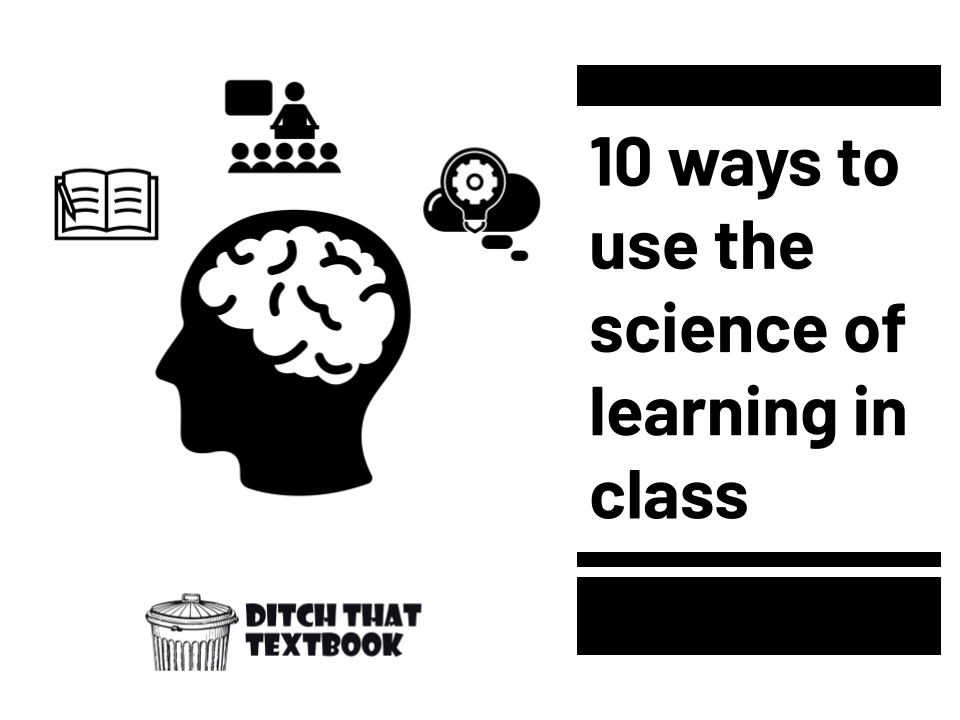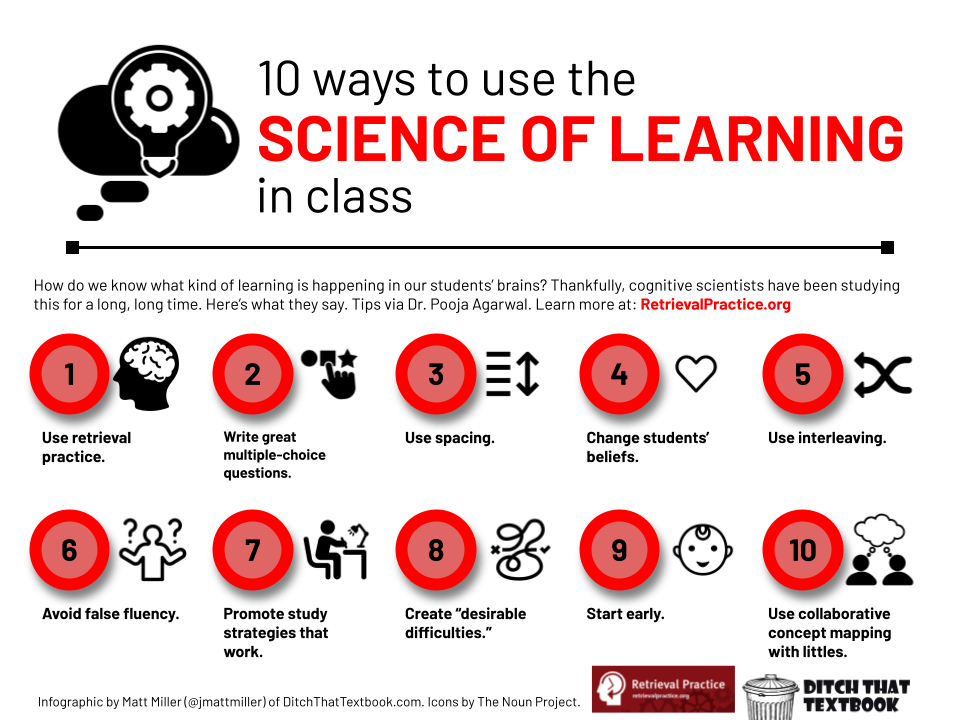
How can we teach -- and our students learn -- the way the brain prefers? These strategies based on the science of learning can be applied in class right away.
How do we know what kind of learning is happening in our students' brains? It can feel tricky to know what to do and what to ask in class to best help our students.
Thankfully, cognitive scientists have been studying this for a long, long time.
They have a lot to tell us. Are we listening, though?
Let's start unleashing the power of the science of learning in the classroom.
Meet Dr. Pooja Agarwal, a cognitive scientist and creator of RetrievalPractice.org, a website that translates brain science for teachers and the classroom.
She has conducted and published well-respected research about the science of learning. But she also shares it widely in her website, on social media (@poojaagarwal and @RetrieveLearn on Twitter) and in Powerful Teaching, a book she co-authored with classroom teacher Patrice Bain.
Why do I introduce her to you?
You've got to see her top 10 list of citations on the science of learning, which is included in this post on the RetrievalPractice.org website.
Want to start including research-based teaching practices in your classroom that will boost memory and learning?
This is a great place to start.
Below are Dr. Agarwal's 10 recommended citations on the science of learning, including my own summary, reflection, and take-aways from each. I'm not a cognitive scientist, so be sure to read them yourself to see if your take-aways match mine!
Note: This list features women, BIPOC (Black, indigenous, and people of color) and LGBTQ+ cognitive scientists, all groups who are disproportionately cited less frequently than men. Citing and amplifying these scientists -- and those like them -- is a simple and quick way you can make a difference. Learn more about the importance of amplifying and citing women in STEM here.
🧠 Want learning to stick in student's long-term memory?
— Matt Miller 🆕 📙 AI for Educators 🤖 (@jmattmiller) April 4, 2023
💡 Here are 10 research-backed teaching strategies.
You can use them in class right away.
(via @poojaagarwal)
🧵 thread (1/12) pic.twitter.com/uNf3xNTZXL


1. Use retrieval practice.
From the journal article: "As researchers have demonstrated for more than a century, retrieval practice -- the active recalling previously learned information -- improves long-term learning and memory. For example, simply retrieving a trivia fact (e.g., what was the name of the ship of Charles Darwin's famous voyage?) helps students remember this fact far better if they simply re-read it multiple times."
Retrieval is such a simple concept. It can be done so quickly. It almost feels like cheating, like it's too good to be true. Just asking students to do what Dr. Agarwal calls a "brain dump" -- where they recall everything they can about a given topic -- can have great benefits.
One other takeaway from the article: The shorter the delay between learning and retrieval, the larger the benefit. Don't wait until the end of the semester to ask students to recall information. Make it a regular part of class.
Read more: Agarwal, P. K., Nunes, L. D., & Blunt, J. R. (2021). Retrieval practice consistently benefits student learning: A systematic review of applied research in schools and classrooms. Educational Psychology Review, 33(4), 1409–1453.

2. Write great multiple-choice questions.
Want students to do better on a multiple-choice test in the future? Progress can be as simple as asking them to practice multiple-choice questions before taking that test.
But we can do even better than that.
There are benefits in writing great incorrect options for multiple-choice questions.
From the journal article: "When multiple choice questions contain competitive incorrect alternatives, test takers are led to retrieve previously studied information pertaining to all of the alternatives in order to discriminate among them and select an answer ..."
Want students to recall what they've learned in class more effectively? Incorrect alternatives that are plausible -- that students think could actually be the right answer -- lead to more solid retrieval from long-term memory.
"... with such processing strengthening later access to information associated with both correct and incorrect alternatives."
All of this leads to better long-term memory and learning in the end.
Read more: Little, J. L., & Bjork, E. L. (2015). Optimizing multiple-choice tests as tools for learning. Memory & Cognition, 43, 14–26.

3. Use spacing.
From the journal article: "Performance on final tests of learning is improved if multiple study sessions are separated -- i.e. "spaced" apart -- in time rather than massed in immediate succession."
I know I learned the hard way in college that cramming doesn't make learning stick. I stayed up late studying, getting ready for quizzes and tests. Some of that studying helped me remember things on the test the next morning. But long after that? All of that studying didn't lead to long-term memory.
Some notes on getting spacing right when studying:
- "If the goal is to retain information for just a short time, shorter spacing gaps may be ideal. However, if the goal is to achieve retention for much longer periods, spacing gaps of several weeks or months may be best."
- "Recent evidence suggests that expanding schedules might be better for short-term retention, and fixed schedules might be better for longer-term retention."
- "In order to promote long-term retention of knowledge, students should receive spaced re-exposure to previously learned information." This can be in the form of a review during instruction, in homework, or in the form of cumulative exams or quizzes.
Read more: Carpenter, S. K., et al. (2012). Using spacing to enhance diverse forms of learning: Review of recent research and implications for instruction. Educational Psychology Review, 24, 369–378.

4. Change students' beliefs.
From the journal article: "A major decision that must be made during study pertains to the distribution, or the scheduling, of study. In this paper, we review the literature on the benefits of spacing, or spreading one's study sessions relatively far apart in time, as compared to massing, where study is crammed into one long session without breaks."
This sounds like the article in #3, right? Keep reading ...
"The metacognitive literature on spacing, however, suggests that massing is the preferred strategy, particularly in young children."
Those students are doing the right thing -- at least in their own minds. They might do it because they haven't been taught otherwise. Or it just might feel like a more powerful learning strategy. (Or maybe spacing feels like too much work.)
A big part of the battle to help students use the science of learning might just be convincing them to change beliefs that aren't backed up by science.
Read more: Son, L. K., & Simon, D. A. (2012). Distributed learning: Data, metacognition, and educational implications. Educational Psychology Review, 24(3), 379–399.

5. Use interleaving.
There's a reason that baseball pitchers don't go straight to the fastball over and over again to try to strike out a batter. The batter would get accustomed to it. The batter wouldn't have to take as much time analyzing which pitch is coming. The batter, then, would knock it out of the park. (That's a good thing for the batter, if you're not big on baseball.)
Simply put: mixing up student practice leads to better long-term learning. It's called interleaving.
From the journal article: "Practicing problems (e.g., 1, 2, 3) of related concepts (e.g., A, B, C) in a mixed-up order (A1 C1 B1 C2 B2 A2 B3 C3 A3; interleaved) can lead to better concept learning than practicing problems one concept at a time (A1 A2 A3 B1 B2 B3 C1 C2 C3; blocked)."
When you combine this with retrieval practice -- see #1 above -- the results are striking. (See what I did there? Striking? Strike? Baseball?)
"One of the leading explanations for the interleaving benefit is that when problems of different concepts are juxtaposed, as is the case with interleaved sequences, learners' attention is drawn to the features that help discriminate between the concepts."
Read more: Sana, F., & Yan, V. X. (2022). Interleaving retrieval practice promotes science learning. Psychological Science, 33(5), 782–788.

6. Avoid false fluency.
If you've ever studied by re-reading your notes, you'll sympathize with this.
You've studied and studied and studied those notes. You know them inside and out. You think you're ready for the test. But when you take the test, you struggle. And you start to wonder, "What good was all of that study time?"
It's not because studying is bad. It's because all of that reading and re-reading gave you a false sense of fluency.
From the journal article: "Viewing blocked exemplars of a given category can lead to a sense of fluency, reinforcing the feeling that blocking enhances inductive learning."
Blocked exemplars. We learned about blocked practice in #5 above -- and how it is less effective. We learned about massing in #4 -- and how it's less effective, too.
"Prior studies ... have shown that a higher subjective ease of processing can lead to higher judgments of learning ... and it may simply feel easier to study exemplars in a blocked schedule. Such experiences, therefore, may be another source of the metacognitive illusion that blocking is more effective than interleaving."
An illusion. Blocking -- practicing similar questions over and over again -- makes you feel like you're improving. In reality, it just feels that way.
Read more: Yan, V. X., Bjork, E. L., & Bjork, R. A. (2016). On the difficulty of mending metacognitive illusions: A priori theories, fluency effects, and misattributions of the interleaving benefit. Journal of Experimental Psychology: General, 145(7), 918.

7. Promote study strategies that work.
Not all study strategies are created equal. When you learn which ones fit the way the brain prefers to learn -- and start to implement them -- it has huge impacts on long-term learning.
Some examples of ineffective techniques for long-term learning, from the journal article:
- Rereading material
- Underlining and highlighting
- Redoing practice problems while having visual access to the solutions
- Attending lectures
Some examples of effective, research-backed techniques include:
- Self-testing (actively trying to retrieve information from memory with as few clues as possible)
- Doing practice problems or exercises
- Thinking of real-life examples
This journal article examines choice of study strategies by students in WEIRD (Western, educated, industrialized, rich, and democratic) countries vs. non-WEIRD countries, accounting also for cultural context, socioeconomic status, and sex. In the article, though, you'll find these effective and ineffective strategies as examples.
Read more: Ekuni, R., de Souza, B. M. N., Agarwal, P. K., & Pompeia, S. (2022). A conceptual replication of survey research on study strategies in a diverse, non-WEIRD student population. Scholarship of Teaching and Learning in Psychology, 8(1), 1–14.

8. Create "desirable difficulties."
From the journal article: "Learning strategies that create 'desirable difficulties' by slowing or hindering improvement during learning often produce superior long-term retention and transfer."
Wait a second. Isn't learning supposed to be easy? And don't the best teachers make it easiest for students?
Not exactly. When students have to struggle to learn, it can lead to better long-term learning.
So ... how do we create desirable difficulties? The article suggests five strategies:
- Finding value: Helping students understand how they'll benefit from the activity or task
- Reducing cost: Helping students see that the perceived struggle they'll endure isn't so high
- Reframing appraisals and attributions: Helping students re-think how they feel about the importance of the task (appraisal) and their perception of why certain outcomes have happened (attribution)
- Creating appropriate challenges: Helping students adjust the skill and challenge to match what they need
- Providing choice: Letting students choose topic, task, objective, pace, schedule and/or structure
Read more: Zepeda, C. D., Martin, R. S., & Butler, A. C. (2020). Motivational strategies to engage learners in desirable difficulties. Journal of Applied Research in Memory and Cognition, 9(4), 468–474.

9. Start early.
Retrieval practice isn't just for older children and adults. Preschool and elementary school students can enjoy the benefits of it. In fact, retrieval-based learning can start as early as infancy with success!
From the journal article: "There is a small but growing literature on retrieval-based learning in children: Retrieval practice boosts recall of word lists in fourth graders (Karpicke, Blunt, & Smith, 2016), helps third graders learn vocabulary terms (Goossens, Camp, Verkoeijen, Tabbers, & Zwaan, 2014), and improves fourth and fifth graders’ memory for map locations (Rohrer, Taylor, & Sholar, 2010)."
Read more: Fazio, L. K., & Marsh, E. J. (2019). Retrieval-based learning in children. Current Directions in Psychological Science, 28(2), 111–116.

10. Use collaborative concept mapping with littles.
Here's a cognitive science-backed teaching strategy that was tested with kindergarteners -- and showed great results!
These kindergarteners participated in "collaborative concept mapping," where they used printed-out pictures of key concepts, identifying relationships between them and linking words that descrbe the relationship between concepts.
This strategy worked! From the journal article: "Results showed significant increases in critical thinking skills in the five week period when learners engaged in collaborative concept mapping supported by mentorship, discussion, and real-life scenarios."
Read more: Sundararajan, N. K., Adesope, O., & Cavagnetto, A. (2018). The process of collaborative concept mapping in kindergarten and the effect on critical thinking skills. Journal of STEM Education, 19(1), 5–13.
More resources about the science of learning (courtesy of RetrievalPractice.org)
- Agarwal, P. K., & Bain, P. M. (2019). Powerful teaching: Unleash the science of learning. Wiley.
- Weinstein, Y., Sumeracki, M., & Caviglioli, O. (2018). Understanding how we learn: A visual guide. Routledge.
- Explore our list of 40 women, BIPOC, and LGBTQ+ cognitive scientists, which includes links to Google Scholar profiles and more recommended research
- Download our database of 50 experiments of retrieval practice research in schools and classrooms
- Download our 7 free practice guides on the science of learning (descarga en español)
- View our lists of more recommended books, podcasts, and resources for students
- Subscribe for our newsletter
- Follow us @RetrieveLearn, follow cognitive scientists on Twitter, and watch on YouTube
- View the document: "10 recommended citations on the science of learning"

